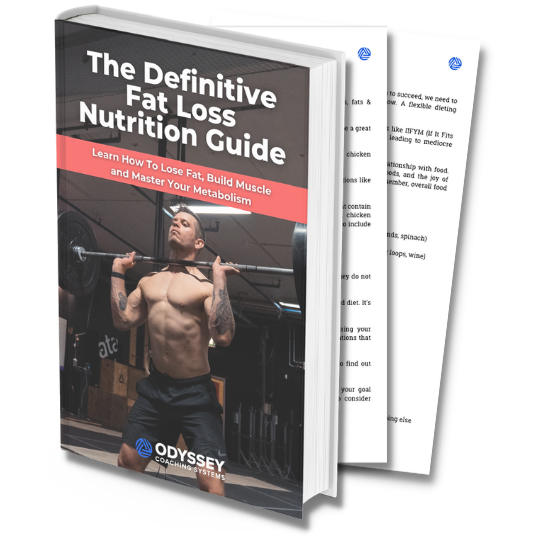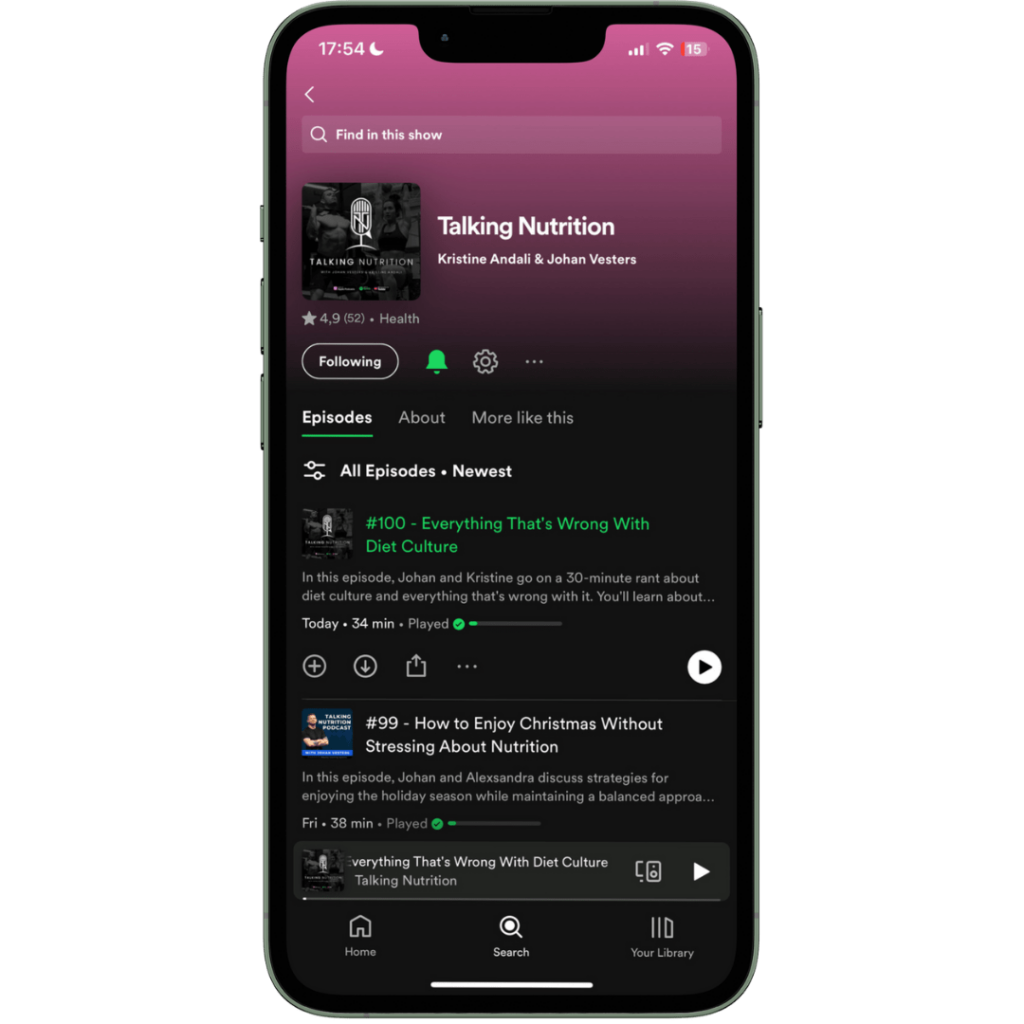Whether your goals are health, physique or performance related, a meal plan can be a great tool.
In a perfect world you’d simply follow along, and get results.
But with the countless options out there, just how are you supposed to figure out what meal plan is the best for you?
In this article we’ll first discuss if a plan is really the thing you need to reach your long term goals.
Then I’ll break down the pros and cons of meal plans for you, followed by why I don’t provide meal plans for my online nutrition coaching clients but instead teach them how to create their own.
And finally, I’ll show you exactly how to make your own macro meal plan.
Do you need a meal plan?
You feel my typical answer coming up already, right?
It depends. (Oh If I got a dollar for every time I used those two words..)
It really does really depend though. So how about this. What if, instead of telling you that you should or shouldn’t follow a meal plan, I help you decide for yourself?
Because meal plans can be super practical. When followed and adjusted in the right way, you can pretty much guarantee results. But as always there are pros and cons.
The pros of following a meal plan
- Convenience and adherence.
Following a plan can be very convenient when you have a busy schedule, because it takes the guesswork out of the equation. You know exactly what, how much, how often and when to eat. This can also help you stick to your nutrition.
- Easy to do shopping.
When you know exactly what you’re going to eat, how many times a week, you can create a weekly shopping list. This can even save you money if you buy certain products in bulk. Personally, that’s what I do for things like rice, oats, etc.
- Food prepping becomes infinitely easier.
Food prepping is already something I recommend, because it can save you a ton of time. But especially if you know what you’re going to be eating on a weekly basis, you’ll make things a whole lot easier for yourself.
- Easy to adjust.
If you have a solid understanding of how nutrition and macros work, you should be able to make adjustments to your plan without a problem. How often you’ll have to adjust your macros and portions will depend on the phase you’re in and how well your body’s responding to your plan at the time.
The cons of following a meal plan
- It doesn’t educate you.
Simply following a plan (that you didn’t create yourself) is convenient, but doesn’t teach you about nutrition. Education is the foundation of long term success. Without it you may see results, but you won’t truly understand why and how.
- Dependency.
Because you don’t understand the why and how, you may become dependent on the plan. Which can be an issue, because you want to know how to do without one too.
- Adherence.
Yep, a meal plan can either improve or mess up your adherence. If you often go to restaurants, friends and family for dinner, a traditional meal plan can become very difficult to stick to.
- Lack of flexibility.
If you’re not provided with both macros and education on how to include flexible foods, a meal plan can become very restrictive. It’s either on or off plan, which can give you a sense of failure when you don’t manage to strictly follow the plan. Instead of learning how to be flexible, you feel like you’re ‘cheating’ any time you have a bigger meal.
- No exit-strategy.
What happens once you reach your goal? Are you just supposed to be eating the same foods to maintain your results? The answer is no, your food intake will ebb and flow depending on the nutritional phase or ‘season’ you’re in at a given point of your fitness journey. Especially after a fat loss phase, your exit strategy is often more important than the actual diet itself. This is why providing you with the right exit strategy is one of the key components of our individualized online nutrition coaching system.
Why our clients don’t get meal plans
We recorded a podcast about flexible dieting vs meal plans. Which I will say isn’t the most positive for meal plans, lol.
But hey, I’m not against them at all. I’m actually on somewhat of a meal plan myself at the moment. I think the right plan can be an amazing tool for you.
So, why won’t I just make you one?
I get asked about meal plans all the time. And to be honest, it would be really easy for me as your coach to send you a one-size-fits-all plan.
It would also be much easier for you to just receive your weekly updated meal plan.
However, easy isn’t what we’re here for, because easy doesn’t lead to real long term sustainable results. I’d be doing you a huge disservice by not pushing you how to figure things out yourself. It would be easy and convenient for us both, sure, but it simply wouldn’t be the right thing to do. Because ultimately you’d want to know how to do without a plan, right?
That’s why I will teach you how to make your own macro meal plan yourself. I will give you instructions and feedback, and will show you how to tweak your macros while allowing for flexibility. But you’re going to be the one taking action. That’s how you really learn, that’s what action-based coaching is.
How to make your own macro meal plan
In case you’re wondering why I’m specifically talking about how to make your own macro meal plan. Why would you even bother with numbers, weighing your food, etc.?
First off, education. If you stick with macros for a while, it’ll overtime teach you a whole lot about foods, nutrients and portion control. Second, this will allow you to ‘go off plan’. A macro meal plan allows you to plug and play when you need to.
- Calculate your calorie requirements by with a tool like our free TDEE & Macro Calculator, which will also automatically do step 2, 3 and 4 for you. However, I do want to explain the process step by step so that you understand the why behind the numbers.
- Calculate your protein requirements by multiplying your body weight (in kg) by about 2.2g. For weight loss don’t go off total body weight, but use your goal weight instead. Protein gives you about 4 calories per gram. Your protein intake is the one aspect of your macro meal plan that does not have to be adjusted from here on.
- Calculate your fat requirements by multiplying your body weight (in kg) by about 0.7 – 0.9g. This is the minimum your body needs for hormonal health. Fat gives you about 9 calories per gram.
- The rest of your calories you can now fill up with carbohydrate. To figure this out you subtract both protein and fat requirements in calories from your total calorie requirements. Carbs give you about 4 calories per gram, so you divide the remaining calories by 4 to get your carbs in grams. Depending on what phase you’re in, most changes to your meal plan will be made through adjusting carbs.
- Now that you have your daily targets for each protein, carbs and fats, decide on how many meals you’d like to have every day. To find out your individual meal targets, all you need to do is divide your daily macro targets by the amount of meals you’d like to have.
- The easiest way to put together a basic, healthy and filling meal is to pick one of each a protein source, a carb source, a fat source and add some color (fruits and/or veggies). Aim to choose minimally processed foods about 80% of the time. These foods will also help keep you full when dieting.
- Plug and play with food amounts to match your targets, close enough will do here. Macros will never be perfect, so don’t worry if you’re slightly over or under. What’s considered super accurate in terms of hitting your daily macros is being within 10g from your protein and carb targets, and within 5g from your fat target.
Sample macro calculations
Let me show what this looks like. To keep it simple I’ll go off my own recent body weight of 100kg, just for easy numbers. Please, remember that these amounts most likely will not apply to you. Since macros are individual, comparing would be pointless.
- Estimated maintenance calories:
3000kcal. - Protein requirements:
100 x 2.2 = 220g. - Fat requirements:
100 x 0.7 = 70g. - Carbohydrate:
3000 – 220 x 4 – 70 x 9 = 1490kcal.
1490 : 4 ≈ 373g. - Meal frequency:
5 - Meal targets:
220 : 5 = 44g protein
70 : 5 ≈ 14g fat
373 : 5 ≈ 75g carbohydrate
Sample meal plans
To give you a few examples of what part of your meal plan may look like, here are two sample meals based on the above mentioned targets. The app I’m using is Cronometer, which is also the same app all of my clients use to track their food.
SAMPLE BREAKFAST
Protein source: Whey Isolate.
Carb source: Oats.
Fat source: Peanut Butter.
Color: Raspberries and Blueberries.
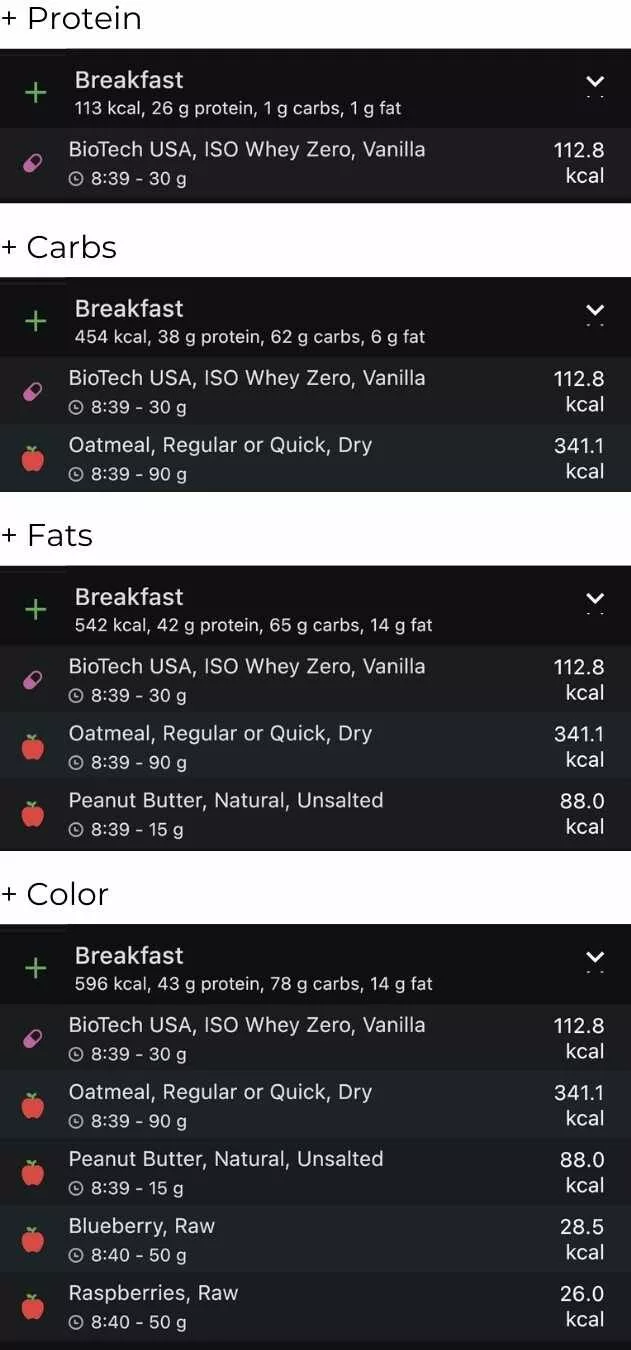
SAMPLE LUNCH
Protein source: Chicken.
Carb source: White Rice.
Fat source: Extra Virgin Olive Oil.
Color: Bell Pepper.
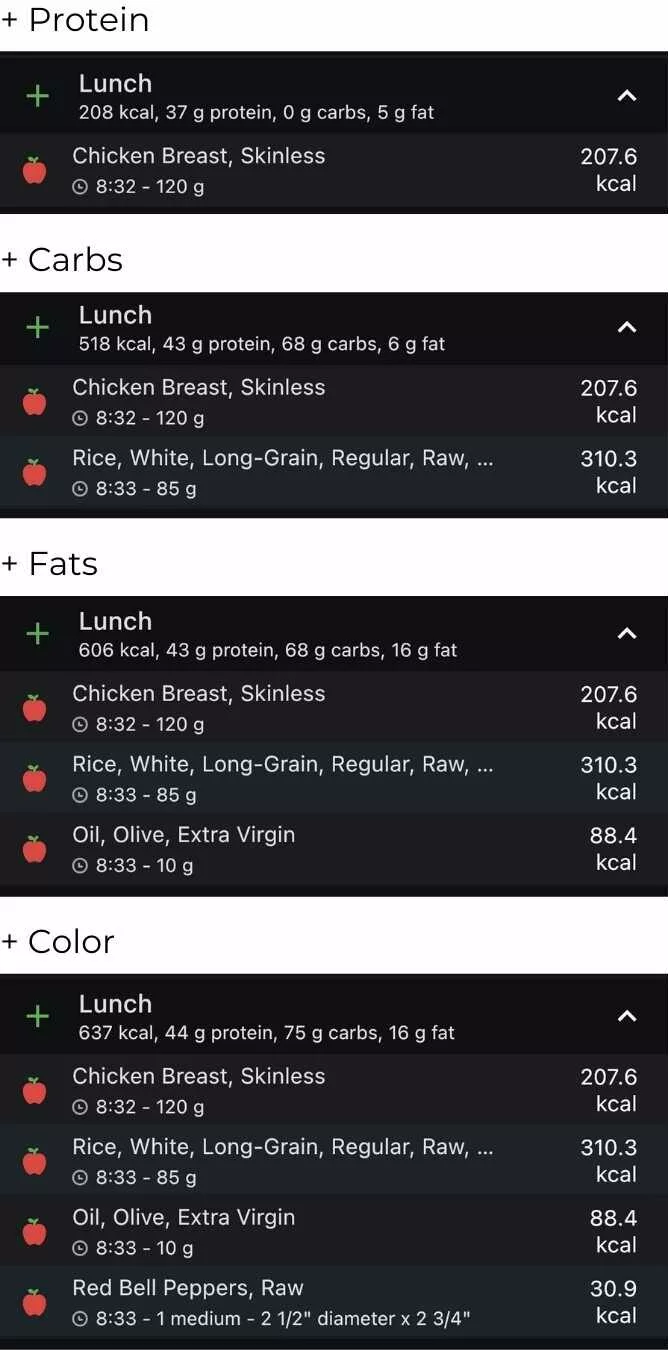
Also check out our ‘Free Meal Plans’ blog for fat loss and muscle gain plans.
‘How To Build Your Own Macro Meal Plan’
This framework is exactly how I personally put together 9/10 of my meals and how I teach my clients to build their own. Now I know that in the beginning there’s a bit of a learning curve, but give yourself some time to figure this out. Anything new takes some getting used to.
No more on or off plan, no more cheating. But instead, flexibility and freedom. Because it’s all part of the plan.
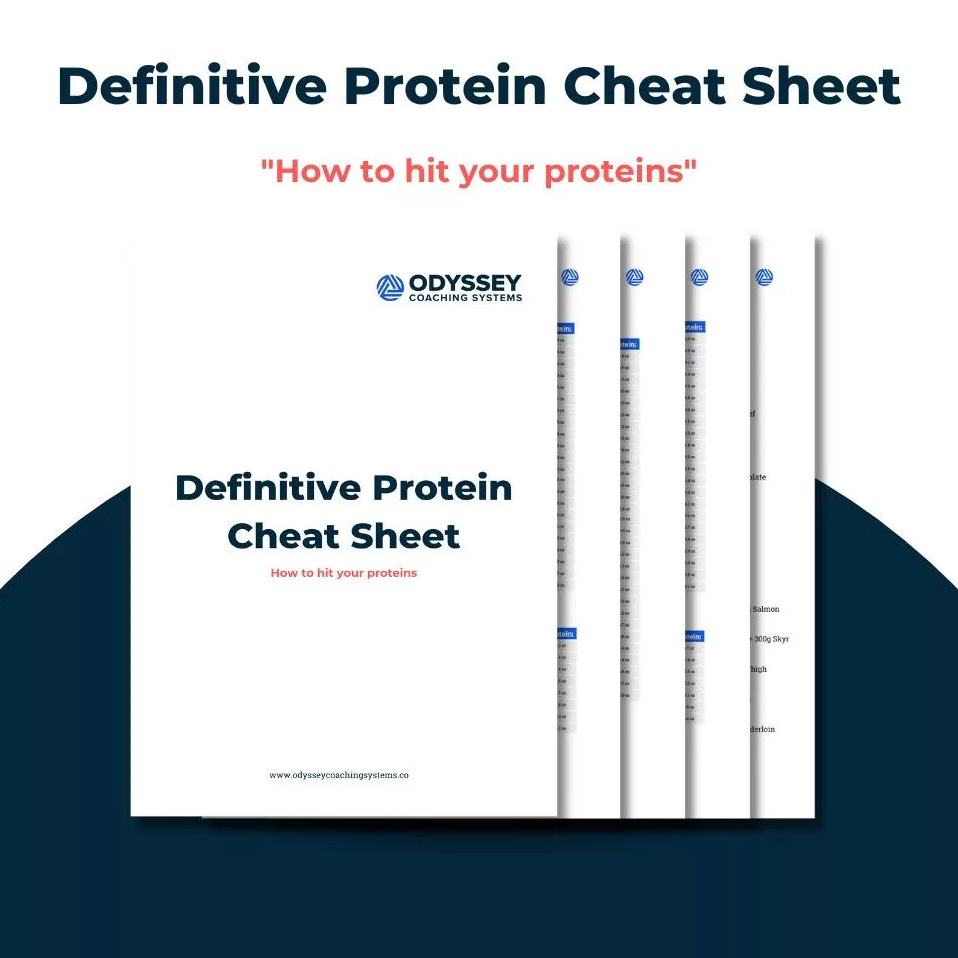
Feel free to play around with meal frequency and nutrient timing based on your preferences, needs, and how you feel. We’ll get more into nutrient timing, in particular for your workouts, in a future article. But for now, let’s keep it simple.
If you decide to go out for dinner, enjoy! Guesstimate food amounts to your best ability, and assume that restaurants usually use a lot more oil or butter. When you have the opportunity, pre-log the meal so that you can puzzle the rest of the day around it. That way, instead of life having to fit into a meal plan, you can now fit your nutrition into your life.



